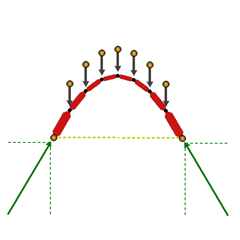
3. Hanging Cable/Arch
 |
3. Hanging Cable/Arch |
| The Screen | The Form Diagram shows a segmental arch with its Force Polygon to the right. The Toggle Switches include |
||||
| Return to Starting Position: Clears away all that
you have done and puts everything back where it was.
Keep supports at same level: Returns the two support points to the same elevation after each change in load or form. Equalize loads: Makes all the loads the same Extend lines of action: Shows the lines of action of the two reactions and the resultant of all the loads on the arch or cable.
|
|||||
| You may move any node that is marked with a yellow
circle. All the other parts of the screen will change instantaneously
to reflect the consequences of each move–the reactions are recalculated,
the force polygon is modified, and the numerical values of member forces
change. The thicknesses of the members will also change.
Notice the color-coding: Loads are gray, reactions are green. Red is compression, blue is tension, and yellow is zero-force. Members and numbers change color as members change from compression to tension to zero force.
|
|||||
| Exercise One | Play | ||||
Use the mouse to play with the arch in any way that you like. Explore the possibilities and become accustomed to how all the features work. Try the various toggles. Notice that there are two ways to see what’s happening to the forces in the segments of the arch or cable:
|
|||||
| 1. The segments grow thicker as forces increase, and thinner
as forces decrease. (Note: There are limits on the thickness and thinness
of the segments. Thicknesses will not change after they reach these limits.)
2. The lines of the Force Polygon grow longer as forces increase, and shorter as forces decrease.
|
|||||
| Exercise Two | Relationship of Force Polygon to Form Diagram | ||||
Toggles On: Keep supports at same level A. Click on the pole, O, of the force polygon, and move it left and right. |
|||||
| What happens to the form of the arch as you do this?
What happens to the forces in the arch?
|
|||||
| B. Increase load FG to about 150: |
|||||
| What is the effect on the form of the arch? Why?
What is the effect on the forces in the arch? What is the effect of this change on the load line?
|
|||||
| C. Click on the right-hand support. Move it back and forth,
increasing and decreasing the span of the arch. |
|||||
What happens to the forces in the arch as its span increases and decreases? Why is this so?
|
|||||
| Exercise Three | The Closing String | ||||
All Toggles Off |
|||||
| What is the geometric relationship between the two yellow
broken lines?
At what point on the load line does the yellow broken line on the force polygon cross the load line? Does this point ever move?
|
|||||
| Exercise Four | Equilibrium of External Forces | ||||
Toggles On: Extend lines of action A. The three external forces on the arch are the two reactions and the
resultant of the loads. Notice that their lines of action are extended. |
|||||
What is the relationship of these three lines of action?
|
|||||
| B. Click on one of the supports and move it up, down, and
around. |
|||||
Does this relationship of the external forces change?
|
|||||
| C. Click on load FG and increase it to about 150. |
|||||
| Does this relationship of the external forces change?
Is there a general rule about the three external forces on an arch that is always true?
|
|||||
| Exercises Five | Role of the Force Polygon | ||||
All toggles off. A. Click on the pole, O, of the force polygon. |
|||||
Move it up and down. Move it right and left. Note the relationship between the pole location and the form and proportions of the arch.
|
|||||
| B. Move the pole, O, slowly toward the load line. Keep going
until it crosses the load line. |
|||||
| What happens to the form of the structure when the pole crosses
the load line? What happens to the character of the forces? Experiment with the hanging structure as you did with the arch. What is the relationship between a funicular arch and a hanging cable
that have the same loads and the same support locations? What is the relationship
between the forces in them if the rise of the arch is the same as the
sag of the cable? |
|||||